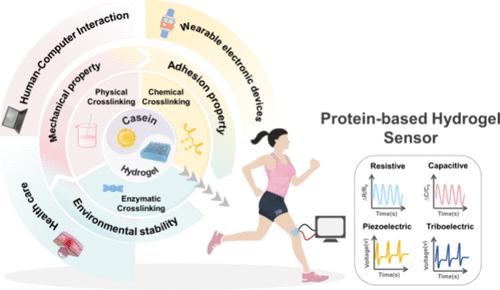Our official English website, www.x-mol.net, welcomes your
feedback! (Note: you will need to create a separate account there.)
Progress in Protein-Based Hydrogels for Flexible Sensors: Insights from Casein
ACS Sensors ( IF 8.2 ) Pub Date : 2024-10-28 , DOI: 10.1021/acssensors.4c01428 Xiaoyu Xu, Qunna Xu, Jianzhong Ma, Yanting Deng, Wen An, Kai Yan, Yan Zong, Fan Zhang
ACS Sensors ( IF 8.2 ) Pub Date : 2024-10-28 , DOI: 10.1021/acssensors.4c01428 Xiaoyu Xu, Qunna Xu, Jianzhong Ma, Yanting Deng, Wen An, Kai Yan, Yan Zong, Fan Zhang

|
In recent years, the rapid advancement of flexible sensors as the cornerstone of flexible electronics has propelled a flourishing evolution within the realm of flexible electronics. Unlike traditional flexible devices, hydrogel flexible sensors have characteristic advantages such as biocompatibility, adhesion, and adjustable mechanical properties and have similar properties to human skin. Especially, biobased hydrogels have become the preferred substrate material for flexible sensors due to increased environmental pressures caused by the scarcity of petrochemical resources. In this regard, proteins possess advantages such as diverse amino acid compositions, adjustable advanced structures, chemical modifiability, the application of protein engineering techniques, and the ability to respond to various external stimuli. These enable the hydrogels constructed from them to have greater designability, flexibility, and adaptability. As a result, their applications in manufacturing various types of sensors have experienced rapid growth. This work systematically reviews the sensing mechanism of protein-based hydrogels, focusing on the preparation of protein-based hydrogels and the optimization of flexible sensors mainly from the perspective of a typical type of animal-derived protein casein. In addition, while the potential of casein is recognized, the limitations of casein-based hydrogels in flexible sensor applications are explored, and insights are provided into the development trends of next-generation sensors based on casein-based hydrogel materials.
中文翻译:

用于柔性传感器的基于蛋白质的水凝胶的研究进展:来自酪蛋白的见解
近年来,作为柔性电子基石的柔性传感器的快速发展推动了柔性电子领域的蓬勃发展。与传统的柔性器件不同,水凝胶柔性传感器具有生物相容性、粘附力和可调节机械性能等特征优势,具有与人体皮肤相似的性能。特别是,由于石化资源稀缺导致环境压力增加,生物基水凝胶已成为柔性传感器的首选基材。在这方面,蛋白质具有氨基酸组成多样、高级结构可调、化学修饰性、蛋白质工程技术的应用以及响应各种外部刺激的能力等优势。这些使由它们构建的水凝胶具有更大的可设计性、灵活性和适应性。因此,它们在制造各种类型传感器中的应用经历了快速增长。这项工作系统综述了基于蛋白质的水凝胶的传感机制,主要从一种典型的动物源性蛋白质酪蛋白的角度出发,重点介绍了基于蛋白质的水凝胶的制备和柔性传感器的优化。此外,在认识到酪蛋白的潜力的同时,探讨了基于酪蛋白的水凝胶在柔性传感器应用中的局限性,并对基于酪蛋白水凝胶材料的下一代传感器的发展趋势提供了见解。
更新日期:2024-10-28
中文翻译:

用于柔性传感器的基于蛋白质的水凝胶的研究进展:来自酪蛋白的见解
近年来,作为柔性电子基石的柔性传感器的快速发展推动了柔性电子领域的蓬勃发展。与传统的柔性器件不同,水凝胶柔性传感器具有生物相容性、粘附力和可调节机械性能等特征优势,具有与人体皮肤相似的性能。特别是,由于石化资源稀缺导致环境压力增加,生物基水凝胶已成为柔性传感器的首选基材。在这方面,蛋白质具有氨基酸组成多样、高级结构可调、化学修饰性、蛋白质工程技术的应用以及响应各种外部刺激的能力等优势。这些使由它们构建的水凝胶具有更大的可设计性、灵活性和适应性。因此,它们在制造各种类型传感器中的应用经历了快速增长。这项工作系统综述了基于蛋白质的水凝胶的传感机制,主要从一种典型的动物源性蛋白质酪蛋白的角度出发,重点介绍了基于蛋白质的水凝胶的制备和柔性传感器的优化。此外,在认识到酪蛋白的潜力的同时,探讨了基于酪蛋白的水凝胶在柔性传感器应用中的局限性,并对基于酪蛋白水凝胶材料的下一代传感器的发展趋势提供了见解。


















































 京公网安备 11010802027423号
京公网安备 11010802027423号